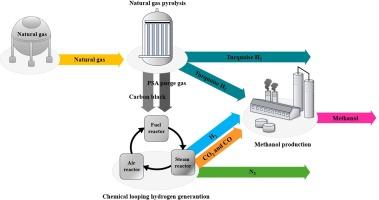利用碳黑生产松石氢的新型甲醇工艺:与化学循环制氢相结合
IF 10.9
1区 工程技术
Q1 ENERGY & FUELS
引用次数: 0
摘要
绿松石制氢是一种具有环境可持续性和经济可行性的方法,其副产品为炭黑。本研究提出了一种将炭黑纳入化学循环制氢(CLHG)的新方法。以往的研究主要根据销售炭黑的收入来评估绿松石制氢的经济可行性。然而,随着绿松石制氢得到更广泛的商业化,过剩的炭黑可能会使市场饱和。因此,有必要探索使用炭黑的替代策略,以保持工艺的经济可行性,而不完全依赖于出售炭黑。本研究提出了一种将绿松石制氢与 CLHG 整合在一起的工艺,使用生产过程中产生的炭黑作为 CLHG 的原料。与单独生产绿松石氢相比,这种集成工艺可将氢气产量提高一倍。生成的氢气与反应过程中产生的二氧化碳 (CO2) 一起用于合成甲醇 (MeOH)。对拟议工艺进行了全面的能源、环境、技术经济和敏感性分析。能源分析表明,总能效为 66.21%。环境分析表明,二氧化碳直接当量(eq.)排放量和二氧化碳总当量(eq.)排放量分别为 0.11 吨/吨 MeOH 和 0.975 吨/吨 MeOH。在不征收碳税的情况下,甲醇的平准化成本为 188.02 美元/吨,在征收碳税的情况下为 216.75 美元/吨,与传统甲醇生产工艺相比,降低了 43.04 %-45.69 %。将绿松石制氢与 CLHG 工艺相结合,并使用炭黑作为原料,为未来的甲醇生产提供了一个前景广阔、经济和环境可持续的解决方案。本文章由计算机程序翻译,如有差异,请以英文原文为准。

A novel methanol production process utilizing carbon black from turquoise hydrogen: Integration with chemical looping hydrogen generation
Turquoise hydrogen production is an environmentally sustainable and economically viable method that generates carbon black as a byproduct. This study presents a novel approach for incorporating carbon black into chemical looping hydrogen generation (CLHG). Previous research has primarily evaluated the economic feasibility of turquoise hydrogen production based on revenue from selling carbon black. However, as turquoise hydrogen gains broader commercialization, the surplus of carbon black could saturate the market. Therefore, it is essential to explore alternative strategies for carbon black use to maintain the economic viability of the process without relying solely on its sale. This study proposes a process that integrates turquoise hydrogen production with CLHG, using carbon black from the production process as feedstock for the CLHG. This integrated process doubles the hydrogen production compared to turquoise hydrogen production alone. The generated hydrogen is then used for methanol (MeOH) synthesis, along with the carbon dioxide (CO2) produced during the reaction. Comprehensive energy, environmental, techno-economic, and sensitivity analyses were conducted for the proposed process. The energy analysis revealed a total energy efficiency of 66.21 %. Environmental analysis revealed that the specific direct CO2 equivalent (eq.) emissions and specific total CO2 eq. emissions were 0.11 t/t MeOH and 0.975 t/t MeOH, respectively. The levelized cost of methanol was $188.02/t without a carbon tax and $216.75/t with a carbon tax, reflecting a 43.04 %–45.69 % reduction compared with the conventional methanol production process. Integrating turquoise hydrogen production with the CLHG process and using carbon black as a feedstock presents a promising, economically, and environmentally sustainable solution for future methanol production.
求助全文
通过发布文献求助,成功后即可免费获取论文全文。
去求助
来源期刊

Energy Conversion and Management
工程技术-力学
CiteScore
19.00
自引率
11.50%
发文量
1304
审稿时长
17 days
期刊介绍:
The journal Energy Conversion and Management provides a forum for publishing original contributions and comprehensive technical review articles of interdisciplinary and original research on all important energy topics.
The topics considered include energy generation, utilization, conversion, storage, transmission, conservation, management and sustainability. These topics typically involve various types of energy such as mechanical, thermal, nuclear, chemical, electromagnetic, magnetic and electric. These energy types cover all known energy resources, including renewable resources (e.g., solar, bio, hydro, wind, geothermal and ocean energy), fossil fuels and nuclear resources.
 求助内容:
求助内容: 应助结果提醒方式:
应助结果提醒方式:


